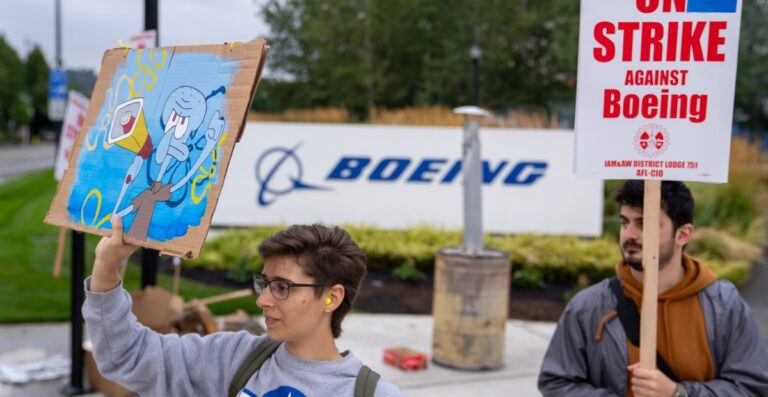At 12:01 a.m. Friday, 33,000 Boeing workers in the Seattle and Portland areas affiliated with the International Union of Machinists and Aerospace Workers (IAM) went on strike.
This is the first time since 2008 that workers at Boeing, one of the world’s two largest commercial aircraft suppliers, have gone on strike. Although the strike will not affect commercial aviation, the strike, which affects about 20% of Boeing’s workforce, could cost the company as much as $1 billion per week and will likely further dent the company’s already struggling stock price. It could also have ramifications for the U.S. economy as a whole. Boeing is one of the largest manufacturers in the U.S., and if the strike drags on, it could affect about 10,000 of its suppliers in all 50 states.
Boeing and IAM have been negotiating a new contract for weeks, and on Sunday appeared to reach an agreement that would provide a 25% wage increase over the next four years and new benefits for employees. IAM leaders encouraged union members to accept the deal, but 96% voted to reject it, setting the stage for a strike on Friday after the old contract expires.
Union members say the pay rise is not enough to offset rising living costs. They are striking for a 40 percent wage increase, more focus on product safety and the return of pension benefits that were abandoned in the 2014 contract.
IAM workers also are demanding that future Boeing planes be built in union plants in the Pacific Northwest, rather than a non-union plant in South Carolina. It’s part of a trend for Boeing workers to demand a say in the industry’s future. Members of the United Auto Workers union sought input on union involvement in making batteries for electric vehicles during last summer’s strike.
The work stoppages are affecting factories across the Pacific Northwest: Everett and Renton, Wash., where Boeing planes are assembled, Portland, Ore., where parts are manufactured, and Moses Lake, Wash., and Edwards Air Force Base, Calif., where planes are stored and repaired.
Boeing workers can have real influence
If the strike begins, it’s possible that Boeing workers will win further concessions from the company. In particular, dissatisfaction with Boeing’s major customers, namely major airlines like Southwest, Alaska and American, could give IAM greater leverage. Many commercial flights are full, and orders for the company’s 737 and 777 planes are already delayed. Airlines have also had to deal with major problems with Boeing planes in recent years, including a horrific incident in January when a door plug flew off during an Alaska Airlines flight, and two fatal accidents in 2018 and 2019. The company has been embroiled in multiple legal battles due to catastrophic safety defects.
“You’re talking about the major airlines,” Art Wheaton, director of labor studies at Cornell University’s School of Industrial and Labor Relations, told Vox. “People aren’t scared to get on a plane. [Boeing is] “You’re putting pressure on your major customers, the airlines, who are saying, ‘Hold on, don’t bother your people. We want you to get it right. We don’t want any issues or problems.'”
A series of cascading crises have caused Boeing to lose an estimated $27 billion since 2019. It now has $60 billion in debt and its stock price has fallen 38% so far this year. Boeing’s aerospace programs have also been hit by some recent high-profile difficulties.
The company’s many significant failures, as Vox’s Marin Kogan wrote in March, are due, at least in part, to the company’s highly corporatized organizational structure, which for decades has prioritized shareholder profits over solid engineering. These problems can only be fixed if Boeing invests in the industry-leading engineering it was once known for. And doing so requires the ability to retain a workforce of highly trained employees.
It remains to be seen whether that influence, along with the company’s financial woes, will be enough to get the workers what they want, but it may not be long: As of Friday, both the union and the company said they were ready to return to the negotiating table.


